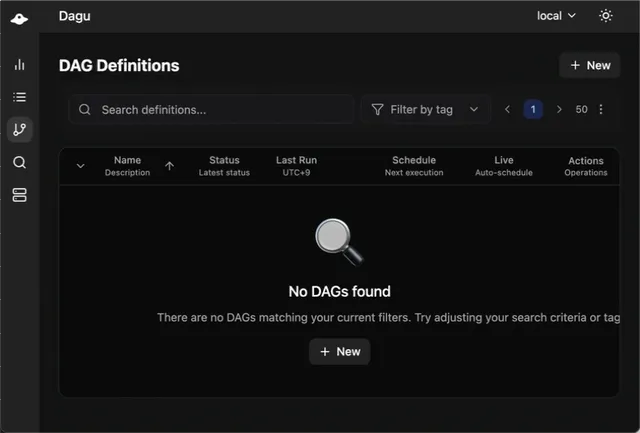What is Dagu?

Dagu is a lightweight workflow engine built in a single binary with modern Web UI. Define any workflow in a simple, declarative YAML format and execute arbitrary workflows on schedule. Natively support shell commands, remote execution via SSH, and docker image. Dagu is a lightweight alternative to Cron, Airflow, Rundeck, etc.
How it Works
Dagu executes your workflows, which are defined as a series of steps in a YAML file. These steps form a Directed Acyclic Graph (DAG), ensuring a clear and predictable flow of execution.
For example, a simple sequential DAG:
steps:
- echo "Hello, dagu!"
- echo "This is a second step"With parallel steps:
steps:
- echo "Step 1"
-
- echo "Step 2a - runs in parallel"
- echo "Step 2b - runs in parallel"
- echo "Step 3 - waits for parallel steps"Or with explicit dependencies:
type: graph
steps:
- name: step 1
command: echo "Hello, dagu!"
- name: step 2
command: echo "This is a second step"
depends: step 1Demo
CLI Demo: Create a simple DAG workflow and execute it using the command line interface.

Web UI Demo: Create and manage workflows using the web interface, including real-time monitoring and control.

When to Use Dagu
Perfect for:
- Data pipelines and ETL
- DevOps automation
- Scheduled jobs and batch processing
- Replacing cron with something manageable
- Local development and testing
Not ideal for:
- Sub-second scheduling requirements
- Real-time stream processing
Quick Comparison
| Feature | Cron | Airflow | Dagu |
|---|---|---|---|
| Dependencies | ❌ Manual | ✅ Python only | ✅ Any language |
| Monitoring | ❌ Log files | ✅ Web UI | ✅ Web UI |
| Setup Time | ✅ Minutes | ❌ Hours/Days | ✅ Minutes |
| Infrastructure | ✅ None | ❌ Database, Queue | ✅ None |
| Error Handling | ❌ Manual | ✅ Built-in | ✅ Built-in |
| Scheduling | ✅ Basic | ✅ Advanced | ✅ Advanced |
Learn More
- Quick Start Guide - Up and running in 2 minutes
- Core Concepts - Understand how Dagu works
- Examples - Ready-to-use workflow patterns